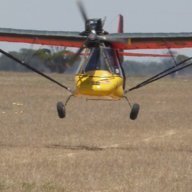What I would like is a table of prop, pitch, reduction ratios, rpm for a number of combinations.
For instance - 68" brolga 3 blade composite, 12* pitch, 2.58 reduction box on a 582, ? rpm.
What about if it was a 3:1 reduction drive, or a 62", or 15* pitch?
I think you get my drift, but I can't seem to find one anywhere - just drawing blanks at the moment.
Cheers,
Pud


